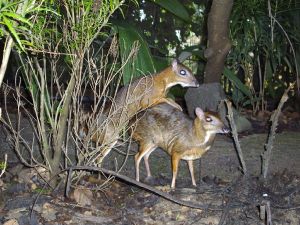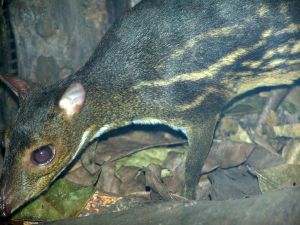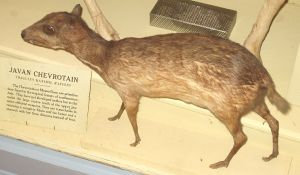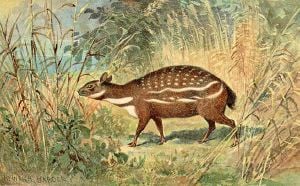| Chevrotains |
||||||||||||
|---|---|---|---|---|---|---|---|---|---|---|---|---|
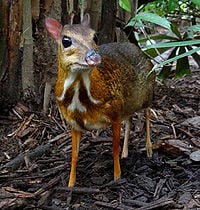
Tragulus kanchil
|
||||||||||||
| Scientific classification | ||||||||||||
|
||||||||||||
|
|
||||||||||||
|
Chevrotain and mouse deer are common names for any of the small ruminant mammals comprising the family Tragulidae of the suborder Ruminantia and order Artiodactyla (even-toed ungulates). The smallest of the hoofed mammals (standing about a foot high at shoulder), they are characterized by slender legs, delicately built hoofs, a tapered snout, three fully developed stomach chambers (the fourth, the omasum, is poorly developed), and a primarily solitary, herbivorous, nocturnal behavior; they lack antlers and horns, but males have small, curved, downward protruding, tusklike upper canine teeth. Chevrotains are found in parts of southeastern Asia and Africa.
Although one of the common names is mouse deer, they are not true deer in that they do not belong to the Cervidae family.
The almost exclusively herbivorous tragulids provide an important role in food chains, with their small size making them an important prey for such carnivores as snakes,crocodiles, felines, and birds of prey such as eagles.
Overview and description
As even-toed ungulates (order Artiodactyla), tragulids (chevrotains or mouse deer) are characterized by a double-pulley astragalus (a bone in the ankle joint) and an even number of functional toes (four), with the main limb axis passing between the middle two digits. As ruminants, tragulids digest their food in two steps, first by eating the raw material and regurgitating a semi-digested form known as cud, then by eating the cud, a process called ruminating. They have a four-chambered stomach to ferment tough plant foods, but the third chamber is poorly developed.
There are 10 living (extant) species in three genera (Wilson and Reeder 2005; Groves and Meijaard 2005). The extant species are found in forests in South and Southeast Asia, with a single species in the rainforests of Central and West Africa (Nowak 1999).
Tragulids are small ungulates. Depending on exact species, the Asian species weigh between 0.7 and 8.0 kilograms (1.5 and 18 lb), and the smallest species are also the smallest ungulates in the world (Nowak 1999). The African chevrotain (Hyemoschus aquaticus) is considerably larger at 7–16 kilograms (15–35 lb) (Huffman 2011). Members of the family have legs that are short and thin, which leave them lacking in agility, but also helps to maintain a smaller profile to aid in running through the dense foliage of their environment. The slender limbs end in hoofs. They have four toes on each foot and tragulids sometimes are digitigrade (stands or walks on its digits, or toes). They lack foot scent glands.
All species in the family lack horns, but both genders have elongated canine teeth. These are especially prominent in males where they are large and curved, project out on either side of the lower jaw, and are used in fights (Nowak 1999). They lack upper incisors but have lower incisors. They have premolars with sharp crowns, and lack facial scent glands.
The word "chevrotain" is French, and can be translated as "little goat." The single African species is consistently known as chevrotain (Wilson and Reeder 2005; Nowak 1999; IUCN 2008). The names chevrotain and mouse deer have been used interchangeably among the Asian species (Nowak 1999; Duckworth et al. 2008; Duckworth and Timmons 2008a, 2008b), though recent authorities typically have preferred chevrotain for the species in the genus Moschiola and mouse-deer for the species in the genus Tragulus (Wilson and Reeder 2005). Consequently, all species with pale-spotted or -striped upperparts are known as chevrotains, and all the species without are known as mouse deer or mouse-deer.
Behavior
Tragulids are solitary or live in pairs (Nowak 1999). Though most species feed exclusively on plant material, the water chevrotain occasionally takes insects and crabs, or scavenge meat and fish (Kingdon 1997).
They give birth to only a single young. The young are weaned at three months of age, and reach sexual maturity between five and ten months, depending on species. Parental care is relatively limited. Although they lack the types of scent glands found in most other ruminants, they do possess a chin gland for marking each other as mates or antagonists, and, in the case of the water chevrotain, anal and preputial glands for marking territory. Their territories are relatively small, on the order of 13-24 hectares, but neighbors generally ignore each other, rather than competing aggressively (Dubost 1984).
Some of the species show a remarkable affinity with water, often remaining submerged for prolonged periods to evade predators or other unwelcome intrusion. This has also lent support to the idea that whales evolved from water-loving creatures that looked like small deer (Walker 2009).
Taxonomy
The Tragulidae family was widespread and successful from the Oligocene (34 million years ago) through the Miocene (about 5 million years ago), and they retain a number of primitive traits that appears to have remained almost unchanged from that time.
Traditionally, only four extant species were recognized in the family Tragulidae (Nowak 1999). In 2004, T. nigricans and T. versicolor were split from T. napu, and T. kanchil and T. williamsoni were split from T. javanicus (Meijaard and Groves 2004). In 2005, M. indica and M. kathygre were split from M. meminna (Groves and Meijaard 2005). With these changes, there are 10 extant species. There also are several species only known from fossils (Farooq et al. 2008).
- SUBORDER RUMINANTIA
- Family Tragulidae
- Genus Hyemoschus
- Water Chevrotain, Hyemoschus aquaticus
- Genus Moschiola
- Indian Spotted Chevrotain, Moschiola indica
- Sri Lankan Spotted Chevrotain, Moschiola meminna
- Yellow-striped Chevrotain, Moschiola kathygre
- Genus Tragulus
- Java Mouse-deer, Tragulus javanicus
- Lesser Mouse-deer or Kanchil, Tragulus kanchil
- Greater Mouse-deer, Tragulus napu
- Philippine Mouse-deer, Tragulus nigricans
- Vietnam Mouse-deer, Tragulus versicolor
- Williamson's Mouse-deer, Tragulus williamsoni
- Genus Hyemoschus
- Family Moschidae: musk deer
- Family Cervidae: deer
- Family Giraffidae: giraffe and okapi
- Family Antilocapridae: pronghorn
- Family Bovidae: cattle, goats, sheep, and antelope
- Family Tragulidae
Ancient chevrotains
There are 6 extinct chevrotain genera (Farooq et al. 2008), including:
- Genus Dorcatherium
- Genus Dorcabune
- Genus Afrotragulus Sánchez, Quiralte, Morales and Pickford, 2010 (Sanchez et al. 2010).
- Genus Siamotragulus
- Genus Yunnanotherium
- Genus Archaeotragulus (Métais et al. 2001).
and may include (Vaughan et al. 2011; Sanchez et al. 2009):
- Genus Krabitherium
The Hypertragulidae were closely related to the Tragulidae.
References
ISBN links support NWE through referral fees
- Dubost, G. 1984. Pages 516-517 in D. Macdonald, ed., The Encyclopedia of Mammals. New York: Facts on File. ISBN 0871968711.
- Duckworth, J. W., Hem Sagar Baral, and R. J. Timins. 2008. Moschiola indica. In IUCN Red List of Threatened Species Version 2012.1. Retrieved July 17, 2012.
- Duckworth, J. W., and R. J. Timins. 2008a. Moschiola kathygre. In IUCN Red List of Threatened Species Version 2012.1. Retrieved July 17, 2012.
- Duckworth, J. W., and R. J. Timins. 2008b. Moschiola meminna. In IUCN Red List of Threatened Species Version 2012.1. Retrieved July 17, 2012
- Groves, C., and E. Meijaard. 2005. Intraspecific variation in Moschiola, the Indian chevrotain. The Raffles Bulletin of Zoology Supplement 12: 413-421.
- Farooq, U., M. A. Khan, M. Akhtar, and A. M. Khan. 2008. Lower dentition of Dorcatherium majus (Tragulidae, Mammalia) in the Lower and Middle Siwaliks (Miocene) of Pakistan. Tur. J. Zool. 32: 91-98. Retrieved July 17, 2012.
- Huffman, B. 2011. Hyemoschus aquaticus, water chevrotain. Ultimate Ungulate. Retrieved July 17, 2012.
- IUCN SSC Antelope Specialist Group (IUCN). 2008. Hyemoschus aquaticus. In IUCN Red List of Threatened Species Version 2012.1. Retrieved July 17, 2012.
- Kingdon, J. 1997. The Kingdon Field Guide to African Mammals. Academic Press. ISBN 0124083552.
- Meijaard, I., and C. P. Groves. 2004. A taxonomic revision of the Tragulus mouse-deer. Zoological Journal of the Linnean Society 140: 63-102.
- Métais, G., Y. Chaimanee, J.-J. Jaeger, and S. Ducrocq. 2001. New remains of primitive ruminants from Thailand: Evidence of the early evolution of the Ruminantia in Asia. Zoologica Scripta. 30: 231-248. Retrieved July 17, 2012.
- Métais, G. Y. Chaimanee, J.-J. Jaeger, and S. Ducrocq. 2007. Eocene bunoselenodont Artiodactyla from southern Thailand and the early evolution of Ruminantia in South Asia. Naturwissenschaften 94(6):493-498. Retrieved July 17, 2012.
- Nowak, R. M. 1999. Walker's Mammals of the World, 6th edition. Johns Hopkins University Press. ISBN 0801857899.
- Sánchez, I. M., V. Quiralte, J. Morales, and M. Pickford. 2010. A new genus of tragulid ruminant from the early Miocene of Kenya. Acta Palaeontologica Polonica 55(2): 177–187. Retrieved July 17, 2012.
- Thenius, E. 1950. Über die Sichtung und Bearbeitung der jungtertiären Säugetierreste aus dem Hausruck und Kobernaußerwald (O.Ö.). Verh. Geol. B.-A. 51/2.
- Vaughan, T. A. , J. M. Ryan, and N. J. Czaplewski. 2011. Mammalogy, 5th edition. Sudbury, MA: Jones and Bartlett. ISBN 9780763762995.
- Walker, M. 2009. Aquatic deer and ancient whales. BBC News July 7, 2009. Retrieved July 17, 2012.
- Wilson, D. E., and D. M. Reeder, eds. 2005. Mammal Species of the World, 3rd ed. Baltimore: Johns Hopkins University Press. ISBN 9780801882210.
Credits
New World Encyclopedia writers and editors rewrote and completed the Wikipedia article in accordance with New World Encyclopedia standards. This article abides by terms of the Creative Commons CC-by-sa 3.0 License (CC-by-sa), which may be used and disseminated with proper attribution. Credit is due under the terms of this license that can reference both the New World Encyclopedia contributors and the selfless volunteer contributors of the Wikimedia Foundation. To cite this article click here for a list of acceptable citing formats.The history of earlier contributions by wikipedians is accessible to researchers here:
The history of this article since it was imported to New World Encyclopedia:
Note: Some restrictions may apply to use of individual images which are separately licensed.
